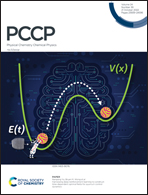A multiscale approach for electronic transport simulation of carbon nanostructures in aqueous solvent†
Abstract
Theoretical works addressing electronic nano-devices operating in an aqueous environment often neglect solvent effects. In order to assess the role played by the polarization effects on the electronic transport properties of solvated graphene, for example in possible bio-sensing applications, we have used here a combination of polarizable force-field molecular dynamics, hybrid quantum mechanics/molecular mechanics (QM/MM) approach, density functional theory, and non-equilibrium Green's function method. We considered different solvation conditions, the presence of defects in graphene, as well as various choices for the partitions between the quantum and classical regions in QM/MM, in which we explicitly account for polarization effects. Our results show that the polarization effects on graphene lead to changes in the structure of interfacial water molecules which are more pronounced in the vicinity of defects. The presence of water leads to increased scattering due to the long-range charge interactions with graphene. At the same time, changes in the conductance due to polarization or salt concentration are found to be small, paving the way for robust electronic nano-devices operating in aqueous environments.



 Please wait while we load your content...
Please wait while we load your content...